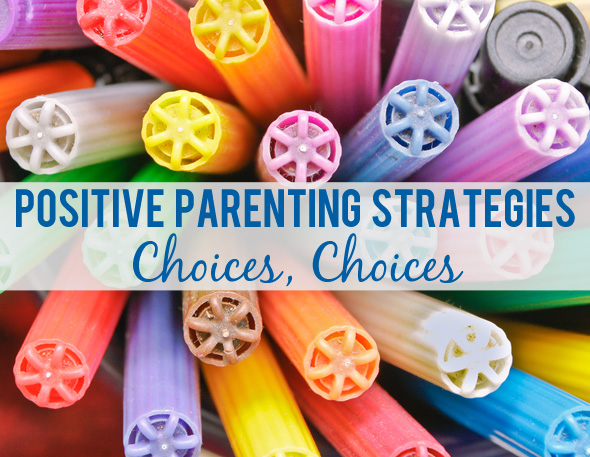Positive Parenting Strategies: Choices, Choices
I often find that when it comes to parenting, it can be the simplest of tips that actually works.
One tip that I always give parents of 2-4 year olds is simply, “choices, choices.” Let me give you and example;
Tonight we got home late for dinner and I was tired and lazy and didn’t clip Immy’s harness when she was sitting in her high chair. Inevitably, part way through the meal, Immy stood up! I said, “Sit down, please.” She said, “No!” Then I remembered my golden rule, “choices, choices,” and said, “Do you want to sit down by yourself or does Mummy need to do it?” She immediately said, “Me,” pointing to herself, and sat down. Then I quickly did up the harness so we did not have a repeat performance!
What a change re-phrasing the request made.
Toddlers love to feel independent. It’s part of their development – they are learning that they are a person independent from everybody else and so they are testing their independence constantly. Hence, you will commonly hear lots of ‘me!’ and ‘no!’ and ‘mine!’ And these can often be accompanied by temper tantrums as toddlers are learning to control their emotions when they don’t get their own way and often do not yet have the words to express how they feel.
By phrasing requests as choices and making one choice your desired outcome (sitting down by herself) and the other choice much less desirable (me doing it for her), you give your child a feeling of greater power – they feel like they are in control of deciding the outcome and you improve the likelihood that the outcome is something you can live with!
Give it a try and let me know how you go.
Related Posts
- 6 Strategies for Dealing With Toddler Tantrums
- 5 Easy Toddler Snacks That Won’t Fill Them Up Before Dinner
- Learning how to play
- Encouragement versus praise


I am forever using rephrasing. But with the preschoolers if I am asking what fruit they would like, I will give them all the choices {as there are some fussy eaters}.
When working with children from diverse backgrounds, sometimes rephrasing is used so they understand the question. This is also the same with toddlers and babies. When you become used to the techniques you use with the older children, I have to remind myself to listen and wait for their answers {wait longer} and sometimes I will need to rephrase.
Perfect example:
P [2.2] drew a picture. I asked "What is your picture of?" He looked at me like I was from Mars. So i tried "What is this?" and pointed to the drawing. He then told me it was paper. I then had to re-rephrase and instead of asking him a question, I commented on his picture. It was then that he told me his drawing was of a truck.
For teachers, I cannot stress the importance of making sure you LISTEN to the children. It is their knowledge and theories you are drawing out – not what you construct from what you think was said etc.
Offering limited choices to 2-4 year olds is an excellent tool to use as a parent, but often I see parents offer choice in the wrong way. I think there are two things to keep in mind:
1 – that the options still result in the same outcome! (whether she sits herself down or you do it for her, she'll still end up sitting!!)
2 – to offer two defined choices. 2-4yr olds aren't usually old enough for open ended choice questions yet, but choosing between two items empowers them. (What would you like to eat? vs Would you like a banana or apple today?)
Great post Christie!!
My nearly 2 1/2 yr old ldaughter oves to choose what to wear. We began going through her entire wardrobe most mornings "do you want to wear this?" – "no!" over and over.
I have since remembered an old friend's advice, give them a choice between 2 outfits and I keep the wardrobe and drawers closed so she can't see anything else.
She gets a little grin on her face when I hold up the options, and after some umming and aahhing I get a very decisive response. Mum & little one both very happy with the result! 🙂
I did it earlier today.
Zoe go and put some socks on…
No
Would you like to pick some socks to put on or do you want me to choose?
You choose
Okay lets go
Result socks on feet.
We talk about sad choices and happy choices in our home. It seems to work when things look like they could go a little pear shaped. It gives Miss M the option to choose the outcome and we have to follow through either way.
Providing choices works right up to late primary-school age kids! Although when you say to a 12 y.o. student, "It's your choice: do you want to do your work now, or stay behind at lunchtime to do it?", they know that's a veiled threat to keep them in at lunch! But I think it's more positive than an outright 'threat' because it reminds them that things are not just imposed upon them: they come about as a direct consequence of the choices they make.
Thanks for the reminder – I try to do this as often as possible but it is still nice to have the reminder – especially when Junior is pushing the boundaries everyday!
I had a laugh reading this. Yes! I do this too and it works a treat.
Great post.
Thanks for this post!
have a 2 year old and need to start doing this 🙂
What about for a 1 year old